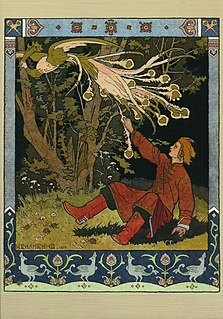
In Finnish mythology, the Sampo or Sammas was a magical artifact of indeterminate type constructed by Ilmarinen that brought riches and good fortune to its holder. When the Sampo was stolen, it is said that Ilmarinen's homeland fell upon hard times and he sent an expedition to retrieve it, but in the ensuing battle it was smashed and lost at sea.

A leprechaun is a type of fairy of the Aos Sí in Irish folklore. They are usually depicted as little bearded men, wearing a coat and hat, who partake in mischief. They are solitary creatures who spend their time making and mending shoes and have a hidden pot of gold at the end of the rainbow. If captured by a human, they often grant three wishes in exchange for their freedom. Like other Irish fairies, leprechauns may be derived from the Tuatha Dé Danann. Leprechaun-like creatures rarely appear in Irish mythology and only became prominent in later folklore.

In mythology, folklore and speculative fiction, shapeshifting is the ability of a being or creature to transform its physical form or shape. This is usually achieved through an inherent ability of a mythological creature, divine intervention or the use of magic. The idea of shapeshifting is present in the oldest forms of totemism and shamanism, as well as the oldest extant literature and epic poems, including works such as the Epic of Gilgamesh and the Iliad, where the shapeshifting is usually induced by the act of a deity.

Simurgh, also spelled simorgh, simorg, simurg, simoorg, simorq or simourv, is a benevolent, mythical bird in Iranian mythology and literature. It is sometimes equated with other mythological birds such as a "phoenix". Persian humā. The figure can be found in all periods of Iranian art and literature and is also evident in the iconography of Georgia, medieval Armenia, the Byzantine Empire, and other regions that were within the realm of Persian cultural influence.

The Bogeyman is a mythical creature used by adults to frighten children into good behaviour. The Bogeyman has no specific appearance, and conceptions vary drastically by household and culture, but is commonly depicted as a masculine or androgynous monster that punishes children for misbehavior. Bogeymen may target a specific act or general misbehaviour, depending on what purpose needs serving, often based on a warning from the child's authority figure.

Mermen are mythical male equivalents and counterparts of mermaids – legendary creatures who have the form of a male human from the waist up and are fish-like from the waist down, having scaly fish tails in place of legs. A "merboy" is a young merman.
A frame story is a literary technique.

The Zmeu is a fantastic creature of Romanian folklore and Romanian mythology. Sometimes compared to other fantastic creatures, such as the balaur or the vârcolac, the zmeu is nevertheless distinct, because it usually has clear anthropomorphic traits: it is humanoid and has legs, arms, the ability to create and use artifacts such as weapons, and has the desire to marry young girls. In some stories, Zmeu appears in the sky and spits fire. In other stories, it has a magical precious stone on its head that shines like the sun. It likes beautiful young girls, whom it kidnaps, usually for the purpose of marrying them. It is almost always defeated by a daring prince or knight-errant. Its natural form is that of a dragon or balaur.
The Afanc is a lake monster from Welsh mythology. Its exact description varies; it is described variously as resembling a crocodile, beaver or dwarf-like creature, and is sometimes said to be a demon. The lake in which it dwells also varies; it is variously said to live in Llyn Llion, Llyn Barfog, near Brynberian Bridge or in Llyn yr Afanc, a lake near Betws-y-Coed that was named after the creature.

In Russian folklore and fairytales the Firebird is a magical glowing bird from a faraway land, which is both a blessing and a bringer of doom to its captor. Some believe it can see the future. The Firebird has its origins in the Slavic mythology.

The xana is a character found in Asturian mythology. Always female, she is a creature of extraordinary beauty believed to live in fountains, rivers, waterfalls or forested regions with pure water. She is usually described as small or slender with long blonde or light brown hair, which she tends to with gold or silver combs woven from sun or moonbeams. The origin of the Asturian word xana is unclear, though some scholars see it as a derivation from the Latin name for the goddess Diana. References to where the mythological xanas lived are still common in Asturian toponyms. They also appear in Eastern Galician and Cantabrian mythology (Anjanas).
A Tuyul or Toyol is a mythical spirit in Javanese mythology of South-East Asia, especially in Indonesia, Brunei, Malaysia, Thailand, and Singapore.
In Irish mythology Tír na nÓg or Tír na hÓige is one of the names for the Celtic Otherworld, or perhaps for a part of it. Other Old Irish names for the Otherworld include Tír Tairngire, Tír fo Thuinn, Mag Mell, Ildathach, and Emain Ablach. Similar myths in the northern Celtic cultures include these of Annwn, Fairyland, and Hy Brasil.

The nuckelavee or nuckalavee is a horse-like demon from Orcadian mythology that combines equine and human elements. It has its origins in Norse mythology, and is the most horrible of all the demons of Scotland's Northern Isles. The nuck component of its name may be cognate with Nick in Old Nick, a name for the Christian Devil. The nuckelavee's breath was thought to wilt crops and sicken livestock, and the creature was held responsible for droughts and epidemics on land despite being predominantly a sea-dweller.

"The Singing, Springing Lark", "The Singing, Soaring Lark", "The Lady and the Lion" or "Lily and the Lion" is a German fairy tale collected by the Brothers Grimm, appearing as tale no. 88.

The fish-man of Liérganes, is an entity which belongs to the mythology of Cantabria, located in the north of Spain. The fish-man of Liérganes would be an amphibian human-looking being, that looked a lot like a metamorphosis of a real human being who was lost at sea. His story was examined by the Enlightenment writer Benito Jerónimo Feijoo, who claimed that the story of the fish-man of Liérganes was true.
Momal Rano or Mumal Rano is a romantic tale of Momal and Rano from the Sindhi folklore and Rajasthani folklore. It is a multifaceted story that entails adventure, magic, schemes, beauty, love, ordeals of separation and above all romantic tragedy.

Jack and the Beanstalk: The Real Story is a 2001 American television miniseries. It was directed by Brian Henson and was a co-production of Hallmark Entertainment and The Jim Henson Company. It is based on the classic English fairy tale Jack and the Beanstalk. The story was considerably reworked to reflect what Henson believed to be a more ethical, humanist view. The cast includes Matthew Modine, Mia Sara, Jon Voight, and Vanessa Redgrave. Richard Attenborough, Daryl Hannah, and a young James Corden play giants.


















